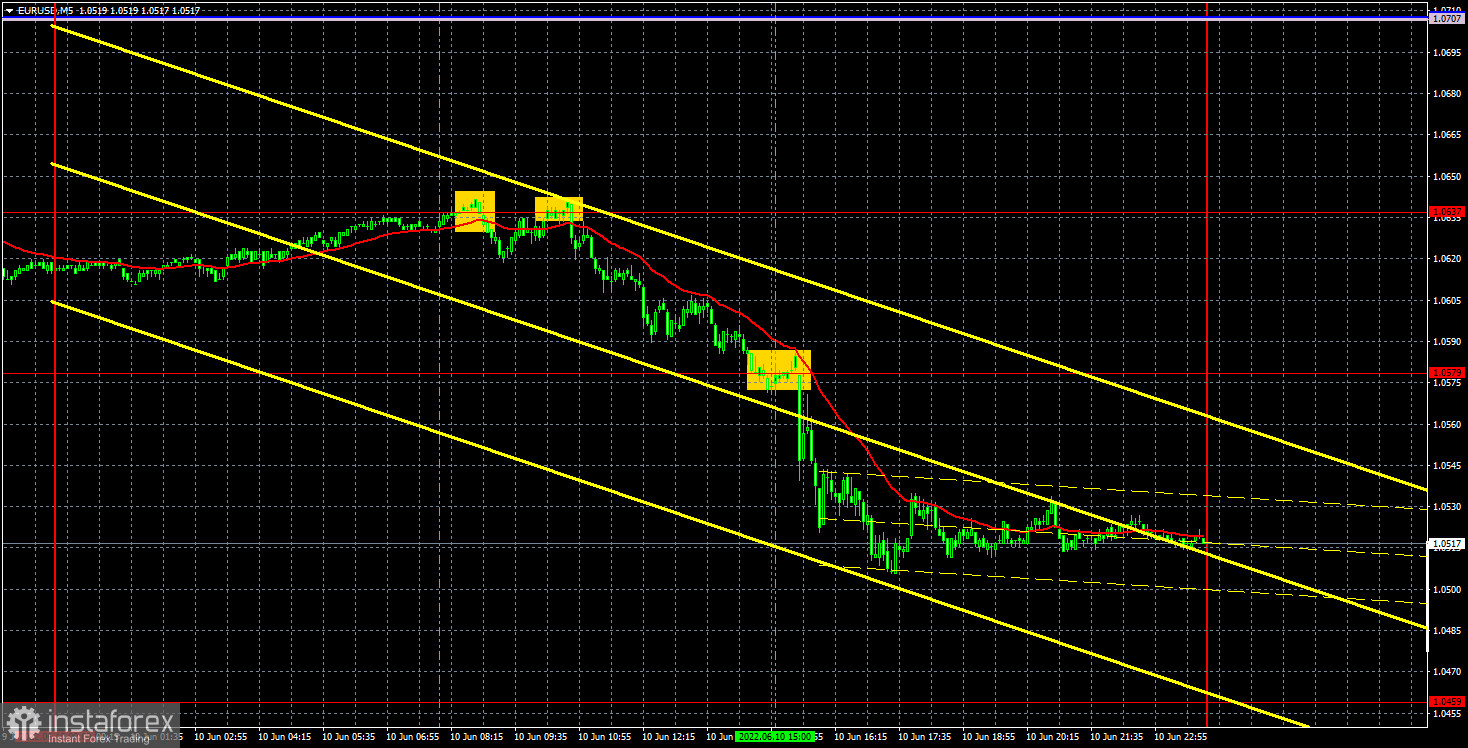EUR/USD 5M analysis.

During the last trading day of the week, the EUR/USD pair continued to fall. In principle, it continued from the very morning, since the European markets did not have time to fully work out the results of the ECB meeting the day before. And although the results themselves cannot be called "dovish", the market decided that this was a great reason for new sales of the euro currency. Well, from our point of view, this is not a completely logical reaction, but we have to accept it. During the American trading session, the euro continued to fall, since, at the very beginning of it, a report on inflation in the United States was published, which recorded its next acceleration. Even despite all the efforts of the Fed to tighten monetary policy. Therefore, another acceleration of inflation means that the regulator will tighten its approach to monetary policy even more. That's why the dollar is rising again.
Trading signals on Friday on the trend and volatile movement were very pleasant. There were only three of them. First, the pair bounced twice from the 1.0637 level, forming sell signals that should have been worked out with a short position. Then the pair also overcame the 1.0579 level, so short positions should be kept open. During the whole day, not a single buy signal was formed, that is, there was no signal to close short positions either. As a result, the transaction should have been closed manually in the late afternoon, and the profit on it was at least 100 points.
COT Report:
The latest COT reports on the euro currency raised a lot of questions. Recall that in the last few months, they have shown a frank "bullish" mood of professional players, but at the same time, the European currency has been falling all the time. At this time, the situation has not changed. The European currency tried to show growth, but last week it collapsed like a stone. Therefore, we again have a situation in which the mood of the major players is "bullish", but the euro is falling at the same time. During the reporting week, the number of buy contracts decreased by 6.3 thousand, and the number of shorts from the "Non-commercial" group decreased by 4.5 thousand. Thus, the net position decreased by 1.8 thousand contracts per week. The number of buy contracts exceeds the number of sell contracts from non-commercial traders by 50 thousand. The second indicator in the illustration above perfectly shows that the net position has been positive for a long time, and the chart of the pair's movement in the same illustration shows a downward movement. From our point of view, this is because the demand for the US dollar remains much higher than the demand for the euro currency. The "respite" for the euro, which has been observed in recent weeks, did not last long, and the global downward trend remains in force. Therefore, we believe that it is still impossible to rely on the data of COT reports on the euro currency when predicting the future movement of the euro/dollar pair.
EUR/USD 1H analysis.
On the hourly timeframe, the pair completed the flat and resumed the downward trend. Now the European currency is flying towards 20-year lows again, to which about 150 points remain. It is unlikely that anything will be able to save the euro this time from their renewal. Traders have adjusted the euro currency up enough to now have enough reasons to resume the hike to the South. On Friday, we allocate the following levels for trading - 1.0459, 1.0579, 1.0637, 1.0765, 1.0806, as well as the Senkou Span B (1.0707) and Kijun-sen (1.0640) lines. The lines of the Ichimoku indicator can move during the day, which should be taken into account when determining trading signals. There are also auxiliary support and resistance levels, but no signals are formed near them. Signals can be "bounces" and "overcoming" levels-extremes and lines. Do not forget about placing a Stop Loss order at breakeven if the price went in the right direction of 15 points. This will protect against possible losses if the signal turns out to be false. There are no interesting reports or other important events scheduled for June 13 in the European Union and the United States. Thus, during the day, traders will have nothing to react to, and the pair has a good opportunity to adjust slightly against a drop of 200 points.
Explanations of the illustrations:
Price levels of support and resistance (resistance /support) - thick red lines, near which the movement may end. They are not sources of trading signals.
Kijun-sen and Senkou Span B lines - the lines of the Ichimoku indicator, transferred to the hourly timeframe from the 4-hour one. Are strong lines.
Extreme levels - thin red lines from which the price bounced earlier. They are sources of trading signals.
Yellow lines - trend lines, trend channels, and any other technical patterns.
Indicator 1 on the COT charts - the net position size of each category of traders.
Indicator 2 on the COT charts - the net position size for the "Non-commercial" group.





















